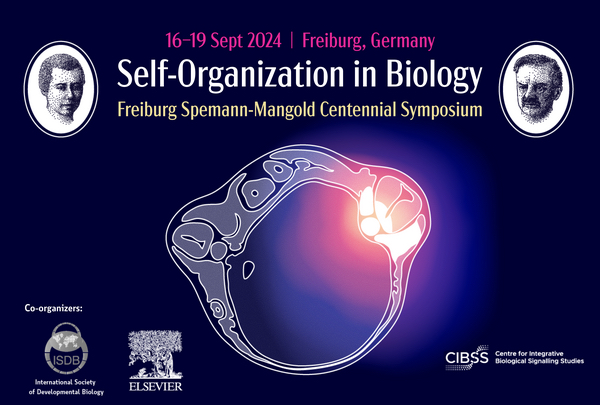

–
·
Mon–Thu
Self-Organization in Biology: Freiburg Spemann-Mangold Centennial Symposium
Self-Organization in Biology: Freiburg Spemann-Mangold Centennial Symposium celebrates 100 years of scientific advances rooted in Hilde Mangold’s and Hans Spemann’s discovery of the gastrula organizer in vertebrate development, published in 1924 and awarded the Nobel Prize in Physiology or Medicine in 1935.
It builds a bridge to today’s molecular and cellular understanding self-organization in developing systems, including signaling centers and tissue organizers, gastrulation, stem cell organoids, morphogen gradients, invertebrate systems, and Evo-Devo.
The Spemann-Mangold gastrula organizer was the first signaling center discovered in vertebrate development and established the concept of embryonic induction: signaling centers induce germlayers, tissue pattern along the embryonic axis, and organ development.

Conference Committee
Wolfgang Driever, CIBSS, University of Freiburg, Germany
Roberto Mayor, University College London, UK
Edward De Robertis, University of California, USA
Local Organizing Commitee
Martin Blum, University of Hohenheim, Germany
Anne Classen, CIBSS,University of Freiburg, Germany
Peter Walentek, CIBSS,University of Freiburg, Germany
Invited Speakers
- Detlev Arendt, European Molecular Biology Laboratory, Germany, Evolution of self-organization in animal development
- Makoto Asashima, University of Tokyo, Japan, Spemann-Mangold organizer and mesodermal induction by Activin
- Alexander Aulehla, EMBL Heidelberg, Germany, Cycles upon cycles – collective rhythms during medaka development
- Marianne Bronner, California Institute of Technology, USA, Gene regulatory landscape mediating neural crest identity along the body axis
- Edward De Robertis, University of California, USA., The Cell signaling pathways that organize cell differentiation from egg to tailbud
- Danelle Devenport, Princeton University, USA, Multicellular self-organization of planar cell polarity
- Denis Duboule, University of Geneva, Switzerland, Using pseudo-embryos to enter the neck of the developmental hourglass
- Brigitte Galliot, University of Geneva, Switzerland, Organizer formation, organizer maintenance & cellular plasticity in Hydra
- Kat Hadjantonakis, Memorial Sloan Kettering Cancer Center, USA, Guts and gastrulation: cellular behaviors driving gut endoderm morphogenesis in the mouse embryo
- Richard Harland, University of California, Berkeley, USA, Is the cellular basis for gastrulation a self-organizing process?
- Thomas Holstein, Heidelberg University, Germany, The Significance of Ethel Browne's research on Hydra for the organizer concept
- Dagmar Iber, ETH Zürich D-BSSE, Switzerland, Developmental Timing, Patterning & Evolution
- Ray Keller, University of Virginia, USA, The organizer: Organizing the forces that shape the xenopus embryo
- Anna Kicheva, ISTA Vienna, Austria, Growth and patterning of the developing spinal cord
- Roberto Mayor, University College London, UK, Chemo-mechanical signal in embryonic induction
- Alfonso Martinez Arias, Universidad Pompeu Fabra Barcelona, Spain, Intrinsic and extrinsic organizers of mammalian body plan: an embryo model perspective
- Kate McDole, MRC Laboratory of Molecular Biology, UK, Illuminating mechanisms of mammalian morphogenesis: emergence and dynamics of the midline
- Anming Meng, Tsinghua University, China, Maternal Erk1/2 is required for organizer and body axis formation via multiple mechanisms in the zebrafish
- Mary Mullins, University of Pennsylvania, USA, A novel mechanism of Spemann-Mangold dorsal organizer repression
- Christof Niehrs, Institut für Molekulare Biologie gGmbH, Germany, Anti-fgf signaling governs left-right body axis formation
- Ángela Nieto, Instituto de Neurociencias CSIC-UMH, Spain, The epithelial to mesenchymal transition in early heart development: from left-right asymmetry to disease susceptibility in adult
- Christiane Nüsslein-Volhard, Max-Planck-Institut für Biologie Tübingen, Germany, Genetics and Development: The organizers of the Drosophila embryo
- Stefano Piccolo, University of Padova, Italy, Mechanical forces and their role in organizing cellular neighborhoods
- Daniel Rios-Barrera, Universidad Nacional Autónoma de México, Mexico, Morphogenesis across scales: The role of the ECM in coordinating tissue development during Drosophila embryogenesis
- Adrienne Roeder, Cornell University, USA, Stochasticity and robustness in the morphogenesis of Arabidopsis sepals
- Siegfried Roth, University of Cologne, Germany, Neofunctionalization of Toll signaling: the evolution of dorsoventral pattering in Insects
- Alejandro Sanchez Alvarado, Stowers Institute for Medical Research, USA, Dissecting the Biological Complexity of Animal Regeneration: The cellular agents of regeneration in planarians
- Alexander Schier, University of Basel, Switzerland, Nodal signaling
- Amy E. Shyer, The Rockefeller University, USA, Supracellular organization of morphogenesis
- Lila Solnica-Krezel, Washington University, USA, The roles of BMP signaling in regulating the gastrulation convergence & extension Movements
- Claudio Stern, University College of London, UK, Establishment of embryonic polarity in amniotes and the origin of identical twins
- Ben Steventon, University of Cambridge, UK, Multi-scale control of pattern regulation during body axis elongation
- Yi-Hsien Su, Institute of Cellular and Organismic Biology, Taiwan, Tracing the evolutionary origin of the gastrula organizer-derived notochord in non-chordate deuterostomes
- Hiroyuki Takeda, Kyoto Sangyo University, Interpretation of the organizer-mediated BMP gradient in late development – Insights from the spontaneous medaka mutant, Da
- Patrick Tam, CMRI, University of Sydney, Australia, Molecular Architecture underpinning the Organization of the Body Plan of Mouse Embryo at Gastrulation
- Ulrich Technau, University of Vienna, Austria, Development and Self-organisation of the axis organizer in cnidarians
- Naoto Ueno, National Institute for Basic Biology, Japan, Epithelial cell dynamics feedback to cell-cell and cell-substrate adhesion via ZO-1 remodeling
- John Wallingford, University of Texas at Austin, USA, Convergent extension in the Xenopus organizer
- Val Wilson, The University of Edinburgh, UK, Organising axial progenitors for a complete head-to-tail axis
- Jennifer Zallen, Memorial Sloan Kettering Cancer Center, USA, Read more about Jennifer Zallen
- Magdalena Zernicka-Goetz, Caltech and University of Cambridge, UK, Embryo models from stem cells: the principles of self-organization
Organizers
ISDB – International Society for Developmental Biology
ELSEVIER
Supporting Organizations:
CIBSS – Centre for Biological Signallng Studies
DFG – Deutsche Forschungsgemeinschaft
GfE – Gesellschaft für Entwicklngsbiologie
GSCN – German Stem Cell Network
SGBM – Spemann Graduate School of Biology and Medicine
Verein zur Förderung der Fakultät für Biologie der Universität Freiburg



